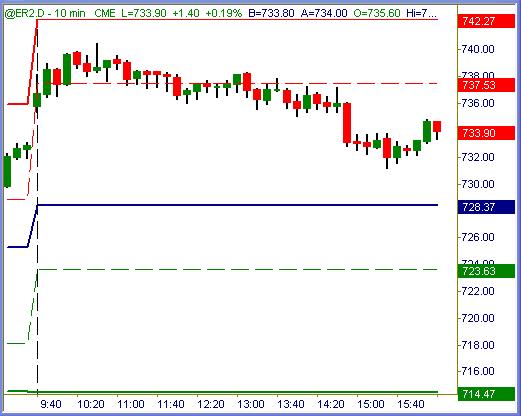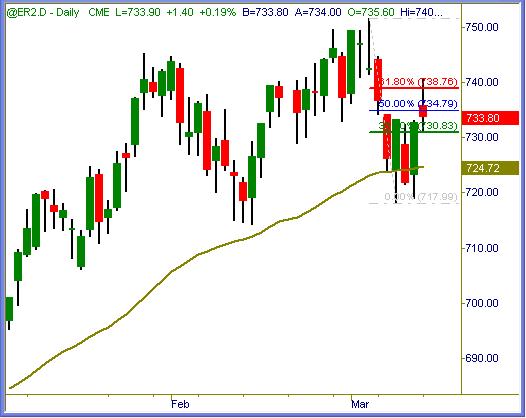What if…?
S&P 500 futures lifted
into R1 resistance early on, then spent the remainder of Monday
drifting & chopping their way lower. It was a 6.5pt total range from top to
bottom, just one of those quiet sessions where nothing much happened.
Russell 2000 futures popped above their R1 value
and spent most of the day chopping across that level. A late afternoon dip
filled the opening gap, which held into the closing bell. Very sideways in
rather choppy fashion.
ES (+$50 per index point)

ER
(+$100 per index point)

ES (+$50 per index point)

Daily chart of the S&P shows more of the same…
sideways gyration. Monday’s spider doji candle marks indecision, which has been
the overall theme for months now.
ER
(+$100 per index point)

Likewise, the small caps dojied (can we use that
as a verb?) yesterday within the center of this sideways roll lasting 42
sessions and counting. Eight weeks of congestion, one more day added to the mix.
S&P’s Survival
Recently we’ve enjoyed a brief return of what I label as more normal volatility
and intraday range movement… "normal" being a relative term.
I received a lengthy email from one reader who
asked what I would do if volatility and intraday ranges continued to contract in
the future. Perhaps the better question might be, "What would the market
itself do if that scenario happened?"
Financial markets exist to provide liquidity.
Such liquidity is provided (in all reality) from a constant stream of changing
players as some quit the profession while others join the fray. If there is a
net outflow of players leaving while dwindling numbers of new recruits come in,
liquidity wanes. Basic supply and demand to volume and open interest overall.
Liquidity permits a greater number of
participants to make money. There is a difference between profit opportunity
inside the S&P 500 versus the S&P 400 emini markets. The former symbol supports
numerous professional program arbitrage traders, hedge funds, large speculators
and small retail traders. The latter symbol can be impossible to clear five
contracts on an order without incredible slippage during low volume bars. A
world of difference, solely based on player participation to create liquidity.
Let’s assume for a moment that volatility and
ranges continue to contract inside emini markets. What if the average intraday
range becomes four index points in width, more days than not. What may happen
next?
For sure there are some traders who can make
money from such a range. But, that group is a very small percentage of the
current population of traders. What do you think the majority of emini traders
would do if faced with a steady diet of 4pt intraday ranges? What would you do?
I myself would quit trading eminis. Why wouldn’t
I? It’s a whole lot easier to trade FX markets with $1,000+ per contract ranges
than what would be a $200 per contract ES range. Right or right? I myself would
not beat my brains in trying to eke out 1pt scalps from a 4pt total range, if
that’s where the ES market winds up. Neither would the masses, and we have
recent historical proof that this is a fact. Ask any OEX options floor trader
what happened to volume and open interest when stock market volatility
contracted. They will tell you that the vast majority of former OEX traders are
now ES traders. I am one of those traders myself.
The mass exodus from stock index option traders
who struggled to profit from waning volatility would pale in comparison to the
gigantic sucking sound you would hear as "retired" ES traders left that symbol
should trading conditions worsen. There is always somewhere else to go,
something else to trade.
Different World
Before the advent of internet trading and online brokers, a majority of
traders were not intraday focused. They couldn’t be… technology didn’t exist
to allow it. When periods of volatility collapse occurred, it did not impact the
majority of traders’ style. Today, things are far different. The vast majority
of emini traders have an intraday or at least very short-term outlook and style.
If trading conditions become too difficult to sustain current numbers of
participants, there will be a net outflow of players.
That in turn causes lessened volume and open
interest. Waning liquidity impacts big players. Take away small player’s
liquidity, and there is not enough room for the current number of program
traders. Some of them would have to fail, because the thinner market could no
longer support them. That domino effect would likewise force more big traders
out, which would in turn reduce liquidity further. More big traders would turn
their attention elsewhere to find favorable market conditions that would no
longer exist in the eminis.
Present-day emini scalpers aptly pulling +2pt
moves out of an 8pt or greater range average range would find the degree of
difficulty many times harder to do the same thing in a 4pt average range. For
most who are successful at it now, that feat would be impossible then. Where
would those traders then turn? Anywhere but the ES, which is exactly what OEX
traders did in the recent past.
At some point in time, the S&P 500 would move in
the general direction toward the S&P 400 of today. The only difference between
each is liquidity. That liquidity exists to support the current crop of traders
who will turn on their trading screens today. Reduce their ability to perform,
i.e. contract volatility and ranges further, and the entire market contracts as
a whole. Net outflow of traders exceeds net inflow of new recruits, and the
process accelerates.
Summation
None of us knows where financial markets are headed next, nor do we know how
they will get there. I would expect volume, volatility and ranges to expand
inside the stock index markets. If not, no big deal… there are many other
markets to trade, and the migration of traders from one place to another would
continue. I expect the best but prepare for the worst and will react
accordingly. Isn’t that the way we must honestly face every aspect of life in
general?
Trade To Win
Austin P
(Online video clip tutorials…
open access)
Austin Passamonte is a full-time professional
trader who specializes in E-mini stock index futures, equity options and
commodity markets.
Mr. Passamonte’s trading approach uses proprietary chart patterns found on an
intraday basis. Austin trades privately in the Finger Lakes region of New York.
